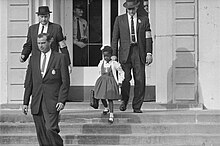
| Part of a series of articles on |
| Racial and ethnic segregation |
|---|
 |
School segregation in the United States was the segregation of students based on their ethnicity. While not prohibited from having schools, various minorities were barred from most schools, schools for whites. Segregation was enforced by formal legal systems in U.S. states primarily in the Southern United States, although elsewhere segregation could be informal or customary. Segregation laws were dismantled in 1954 by the U.S. Supreme Court because of the successes being attained during the Civil Rights Movement. Segregation continued longstanding exclusionary policies in much of the Southern United States (where most African Americans lived) after the Civil War. School integration in the United States took place at different times in different areas and often met resistance. Jim Crow laws codified segregation. These laws were influenced by the history of slavery and discrimination in the US. Secondary schools for African Americans in the South were called training schools instead of high schools in order to appease racist whites and focused on vocational education.[1] After the ruling of Brown v. Board of Education, which banned segregated school laws, school segregation took de facto form. School segregation declined rapidly during the late 1960s and early 1970s as the government became strict on schools' plans to combat segregation more effectively as a result of Green v. County School Board of New Kent County.[2] Voluntary segregation by income appears to have increased since 1990.[2] Racial segregation has either increased or stayed constant since 1990, depending on which definition of segregation is used.[2][3] In general, definitions based on the amount of interaction between black and white students (exposure definitions) show increased racial segregation, while definitions based on the proportion of black and white students in different schools (unevenness definitions) show racial segregation remaining approximately constant.[2]
Residential segregation in the United States and school choice, both historically and currently, have had a considerable effect on school segregation.[4][5] Not only does the current segregation of neighborhoods and schools in the US affect social issues and practices, but it is considered by some to be a factor in the achievement gap between black and white students.[5] Some authors such as Jerry Roziek and Ta-Nehisi Coates highlight the importance of tackling the root concept of racism instead of desegregation efforts that arise as a result of the end of de jure segregation.[6][7] Along with educational and social outcomes, the average income and occupational aspirations of minority households that are products of segregated schooling have worse outcomes than the products of desegregated schooling.[8][9]
More than half of students in the United States attend school districts with high concentrations of people (over 75%) of their own ethnicity and about 40% of black students attend schools where 90%-100% of students are non-white.[10][11]
Blacks, "Mongolians" (Chinese), Japanese, Latino, and Native American students were segregated in California.[12] Native American children faced separation from their families and forced assimilation programs at boarding schools. But there were also cases where Native Americans successfully challenged school segregation and won access to public schools.[13]
- ^ "Black Education and Rockefeller Philanthropy from the Jim Crow South to the Civil Rights Era".
- ^ a b c d Reardon, Sean F.; Owens, Ann (2014). "60 Years After Brown: Trends and Consequences of School Segregation". Annual Review of Sociology. 40 (1): 199–218. doi:10.1146/annurev-soc-071913-043152. ISSN 0360-0572.
- ^ Richmond, Emily (June 11, 2012). "Schools Are More Segregated Today Than During the Late 1960s". The Atlantic. Retrieved January 4, 2022.
- ^ Frankenberg, Erica; Genevieve Siegel-Hawley (November 2009). "Equity Overlooked: Charter Schools and Civil Rights Policy" (PDF). The Civil Rights Project. Retrieved November 4, 2013.
- ^ a b Rothstein, Richard (2019). "The myth of de facto segregation". The Phi Delta Kappan. 100 (5): 35–38. doi:10.1177/0031721719827543. ISSN 0031-7217. JSTOR 26614879. S2CID 151100046.
- ^ Rosiek, Jerry (2019). "School segregation: A realist's view". The Phi Delta Kappan. 100 (5): 8–13. doi:10.1177/0031721719827536. ISSN 0031-7217. JSTOR 26614874. S2CID 150138749.
- ^ Coates, Ta-Nehisi (2015). Between the world and me. New York. ISBN 978-0-8129-9354-7. OCLC 912045191.
{{cite book}}: CS1 maint: location missing publisher (link) - ^ Cite error: The named reference
Wells&Crainwas invoked but never defined (see the help page). - ^ Cite error: The named reference
:6was invoked but never defined (see the help page). - ^ Mervosh, Sarah (February 27, 2019). "How Much Wealthier Are White School Districts Than Nonwhite Ones? $23 Billion, Report Says". The New York Times. ISSN 0362-4331. Retrieved January 4, 2022.
- ^ Stancil, Will (March 14, 2018). "School Segregation Is Not a Myth". The Atlantic. Retrieved January 4, 2022.
- ^ "Constitutional Rights Foundation".
- ^ "How Native American Families Challenged School Desegregation | National Trust for Historic Preservation".
© MMXXIII Rich X Search. We shall prevail. All rights reserved. Rich X Search
